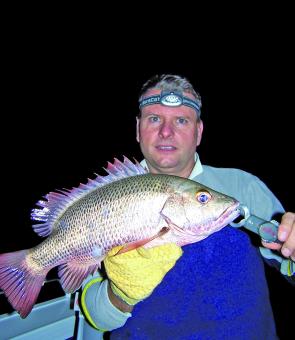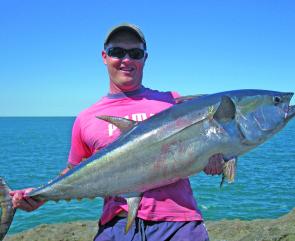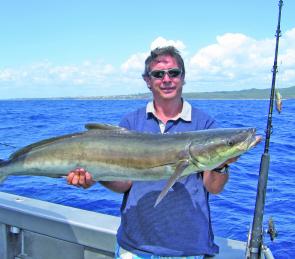Once again we are close to seeing another year out. For me it was a quiet one as far as fishing goes. Business and family commitments have largely kept me off the water, however things will be different throughout 2010!
In Noosa there are options aplenty to explore over the holiday period and right through next year. My favourite target in this area is the indomitable mangrove jack. They are caught offshore, around structure in the lower reaches of any estuary, further upstream along snaggy banks and around rock bars, and right up into the very upper reaches of the smallest of creeks, even into the fresh water.
Jacks are a mean and toothy ambush hunter and as such they are best targeted near structure. Whilst they will venture out to hunt during periods of low light, they will spend the majority of the day under a log, behind a rock or deep in a shadowy enclave of mangrove roots.
These nasty fish will belt a lure or live offering on the turn and before you even register a hit the fish and your offering are already half way back to the lair. Assuming there are oysters and other line destroying objects associated with the underwater structure the battle is already over.
Even in mid water these dirty fighters will often head to structure immediately upon hook-up to rid themselves of the offending lure or hook. I have even known jacks to swim through a crab pot cleverly leaving the lure on the inside and the angler dumbstruck.
Live baiting is a great way to catch jacks and all manner of by-catch along the way. The first task is to collect the livies and a cast net is a great way to do this. Shallow water is the best bet and it generally doesn’t take too long to collect a few herring, mullet and whiting. Make sure the whiting you use as bait are either unregulated or of legal size.
The second part of the equation is structure. Almost anything will do, however most anglers prefer a fallen tree or similar snag that will provide lots of shade on a sunny day and plenty of ambush points. It is a good idea to tie up to a riverside tree and anchor mid stream so the boat is side on to the snag. This allows easy access to the structure from anywhere in the boat.
It can complicate things though if a big jack goes berserk, as they sometimes tend to do, and collects anchor ropes along the way. I have had jacks run back and forth, under and around boats in a frantic, erratic effort to rid themselves of a treble hook. In many cases they succeed.
A good landing net is a must as is a torch or two and of course a good way to keep your live baits in good condition. Lip grippers are also a handy tool as a landed jack will try to bite fingers that get to close and let me tell you the buggers hurt when they latch on!
Other species that can be successfully targeted in the summer months are flathead, bream and whiting along with tasty mud crabs.
Flathead will be widespread and midway through their annual spawning run. This means there will be plenty of large female fish in the river with lots of willing males nearby. Most caring anglers release flatties longer than 60cm to assist with natural recruitment, despite current regulations stating duskies between 40-75cm are in the legal limits to keep. Dusky or mud flathead are by far the most commonly caught flathead sub species in this area.
Trollers sometimes do well when chasing flathead. They will often use bibbed minnow lures that run very close to the bottom structure and trolling the run-out tide is more productive than other phases.
Drifting with live bait, pilchard halves or smaller frogmouth pillies can also work a treat and allow you to cover plenty of territory.
Bream and whiting are prevalent throughout the system. Good places to try are the Frying Pan area and just before the ferry crossing as you make your way upstream.
Offshore there are also options galore. There are plenty of reefs close by such as Halls and Little Halls, North and Sunshine, Chardons and Jew Shoal. All are worth trolling at this time of year for the early run of tuna and mackerel. Have a spin stick at the ready pre-rigged with a slug as boiling schools of tuna are often encountered from December onwards.
Bottom bashers could do a lot worse than trying any of these reefs with snapper, sweetlip, Moses perch, Maori cod, pearl perch and plenty of other surprises on offer. If you struggle to catch a feed go out with a charter boat and pick up a few hints. Guides are an excellent way to learn local knowledge and it’s a good idea to go out with a guide at the beginning of your stay rather than at the end in desperation. That way you can use your newly won knowledge during the rest of your stay.
Options a little further afield include bass up at lakes Macdonald and Borumba, and of course the barramundi impoundments to the north starting with Lenthals near Maryborough and Monduran and Awoonga further up the highway.
Please observe speed limits on the Noosa River and avoid becoming a statistic. The Boating and Fisheries Patrol are busy in this area and will issue fines for speeding, incorrect safety gear, expired flares and no life jackets, as well as non-compliance of the fishing regulations.
Drop into a tackle store for info on what’s biting and where, grab some bait, a yabby pump or a cast net, arm yourself with the latest brochure detailing rules and regulations and get out there and have some safe on water fun.
While in the Noosa district you will see fishing line disposal points. These are designed for exactly that, not all manner of rubbish. Please use these facilities thoughtfully and please dispose of used bait bags in a rubbish bin, not the river. Discarded line can be very damaging to the environment, and to birds in particular, so please do the right thing.
Lastly, many thanks to all of those great people who contribute to this column throughout the year. Merry Christmas!
Reads: 1609
This agro jack did its best to tear Lance McFaydens finger off once it was in the boat after taking a live bait drifted into a snag at night.

A catch out of the ordinary - Peter Morris sight cast an 85g slug to this beast of a longtail from the rocks!

This 12kg cobia was caught recently on a Fishing Offshore Noosa charter.




